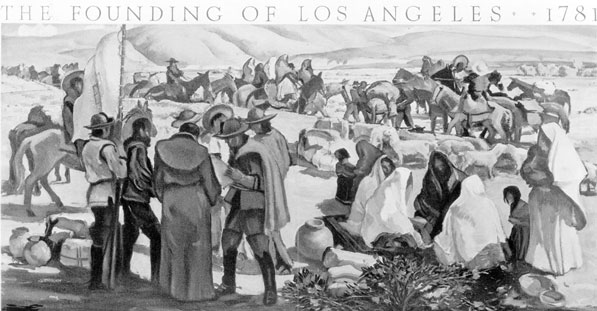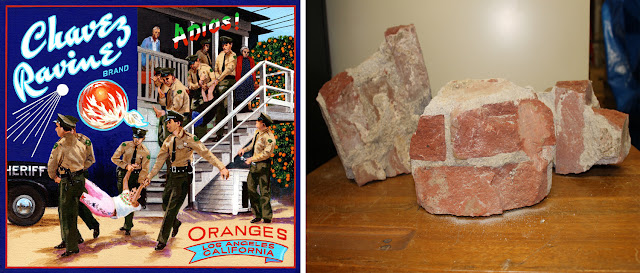Every year since 1981, the City of Los Angeles commemorates this official founding by recreating the journey of Los Pobladores along the historic route they traveled over two hundred years earlier. This year, on Saturday, August 29, 2015, walkers and bikers celebrate the city’s 234th birthday, their journey culminating at El Pueblo de Los Angeles Historical Monument—a 44-acre park in downtown Los Angeles near the site of Los Pobladores’ original destination.
SPAIN’S COLONIALIZATION OF ALTA CALIFORNIA
Since about 500 AD, the Tongva Indians lived in the Los Angeles basin. At the time the Mission San Gabriel Arcángel was established (1771) they were living in the village of Yang-na, near today’s Los Angeles City Hall.
The “founding” of El Pueblo de la Reyna de los Angeles was part of the Spanish empire’s strategy for colonizing Alta California (Upper California) in the province of Las Californias—establishing presidios (military forts), missions, and pueblos (towns).
Pueblo settlers occupied house lots and farmed planting fields. At Alta California, the remote northern frontier of the Spanish empire, they encountered a world of remarkable cultural diversity, inhabited by indigenous people with distinct languages, belief systems, and customs.
Early California settlers like Los Pobladores fit a common mold. Usually of mestizo (Spanish and Native American) or mulato (Spanish and African) status, they immigrated to California from the impoverished and war-torn frontier provinces of northwest Mexico. Such socio-racial designations were part of the Spanish empire’s casta system, an elaborate hierarchy of identities based on racial mixing, economic position, dress, and other factors.
Los Pobladores—eleven families, including twenty-two children—made their home at El Pueblo de la Reyna de los Angeles after traveling a thousand miles from Sinaloa and Sonora, Mexico, where they were recruited to populate Alta California. The new pueblo was the second established by the Spanish Crown, following that of San José on the Guadalupe River southeast of San Francisco Bay.
As historian W. W. Robinson noted, the site of the new settlement had been chosen earlier by Felipe de Neve, the Spanish governor of the Californias, and some families settled there by June 1781. By September 4 that year Neve, who had been in residence at the Mission San Gabriel Arcángel during the summer, legalized the new pueblo’s distribution of lands—plaza, house lots, and planting fields.
 |
| (Left) Hand-drawn copy of a 1786 map of the distribution of pueblo lands by José Arguello, courtesy of the Bancroft Library, UC Berkeley, and (right) translated into English, California Historical Society Collection, USC Libraries |
This year, as part of the city’s founding celebration, the California Historical Society and LA as Subject present the exhibition “History Keepers: Storied Objects from Los Angeles Collections” on view throughout the month of August at the Pico House, one of twenty-seven historic buildings at El Pueblo de Los Angeles Historical Monument.
Featuring documents, maps, posters, and photographs and treasures such as bricks from the original ditch that brought water to the city, an oil-burning orchard heater, and an L.A. history pinball machine, History Keepers brings together a diverse selection of items from a range of collections across the Los Angeles region. Some objects are housed at university libraries, museums, and nonprofit organizations. Still others are held by private collectors in their homes.
History Keepers: Storied Objects from Los Angeles Collections
The Pico House
424 North Main Street
Los Angeles, California
Tues. to Sun. 1:00 am to 4:00 pm
Shelly Kale
Publications and Strategic Projects Manager
skale@calhist.org
Further reading:
Anthony Bevilacqua, “Experiencing Los Angeles and the Walk of the Pobladores,” Anza Trail Blog, September 2014.
Nathan Masters, "Happy Birthday, Los Angeles! But is the Story of the City's Founding a Myth?" KCET, 2011.
California Historical Society, “Life on the Spanish and Mexican Frontier,” in Juana Briones y Su California: Pionera, Fundadora, Curandera online exhibition.
El Pueblo de Los Angeles Historical Monument, My City, My History, a California Education Standards-based curriculum guide for grades K-5.
Nita Lelyveld , “Exhibit’s Treasure Trove Illustrates History of Los Angeles,” Los Angeles Times, August 15, 2015
William Marvin Mason, The Census of 1790: A Demographic History of California (Menlo Park: Ballena Press, 1998).
Doyce B. Nunis, Jr. The Founding Documents of Los Angeles: A Bilingual Edition (Berkeley: University of Calfiornia Press on behalf of the Historical Society of Southern California, 2004)
W. W. Robinson, Los Angeles from the Days of the Pueblo (San Francisco: California Historical Society, 1981)





No comments:
Post a Comment